Business Project: Nestle's Training, Recruitment & Selection Methods
VerifiedAdded on 2021/02/19
|28
|4750
|20
Report
AI Summary
This report presents a case study on Nestle, examining its training, recruitment, and selection methods to meet international requirements. The project begins with an introduction to globalization and its impact on businesses, followed by the project's aims and objectives. It outlines a detailed project management plan, including cost, scope, time, and quality considerations, alongside a Gantt chart and work breakdown structure. The report then delves into the research methodology, covering both qualitative and quantitative research methods, including the use of primary and secondary data. The analysis includes a literature review on the concepts of selection, globalization, training, and recruitment, as well as the methods used by Nestle to meet international standards. It also addresses the issues faced by Nestle in providing training sessions. The report concludes with data analysis, recommendations, and a reflection on the project's findings.

Managing a successful
Business Project
Business Project
Paraphrase This Document
Need a fresh take? Get an instant paraphrase of this document with our AI Paraphraser

Table of Contents
TOPIC:-............................................................................................................................................3
“To examine the training, recruitment and selection methods of multinational organisations in
order to meet international requirements.” A case study on Nestle......................................3
INTRODUCTION..................................................................................................................3
TASK 1............................................................................................................................................3
P1. Project aims and objectives..............................................................................................3
P2 Develop a project management plan.................................................................................5
P3 Gantt chart and work break down structure.....................................................................6
TASK 2............................................................................................................................................9
P4 Qualitative and quantitative research methods..................................................................9
TASK 3..........................................................................................................................................11
P5 Data analysis...................................................................................................................11
P6 Communicate appropriate recommendations..................................................................19
TASK 4..........................................................................................................................................20
P7 Reflection........................................................................................................................20
CONCLUSION..............................................................................................................................20
REFERENCES..............................................................................................................................21
Books & Journals ................................................................................................................21
APPENDIX....................................................................................................................................22
TOPIC:-............................................................................................................................................3
“To examine the training, recruitment and selection methods of multinational organisations in
order to meet international requirements.” A case study on Nestle......................................3
INTRODUCTION..................................................................................................................3
TASK 1............................................................................................................................................3
P1. Project aims and objectives..............................................................................................3
P2 Develop a project management plan.................................................................................5
P3 Gantt chart and work break down structure.....................................................................6
TASK 2............................................................................................................................................9
P4 Qualitative and quantitative research methods..................................................................9
TASK 3..........................................................................................................................................11
P5 Data analysis...................................................................................................................11
P6 Communicate appropriate recommendations..................................................................19
TASK 4..........................................................................................................................................20
P7 Reflection........................................................................................................................20
CONCLUSION..............................................................................................................................20
REFERENCES..............................................................................................................................21
Books & Journals ................................................................................................................21
APPENDIX....................................................................................................................................22
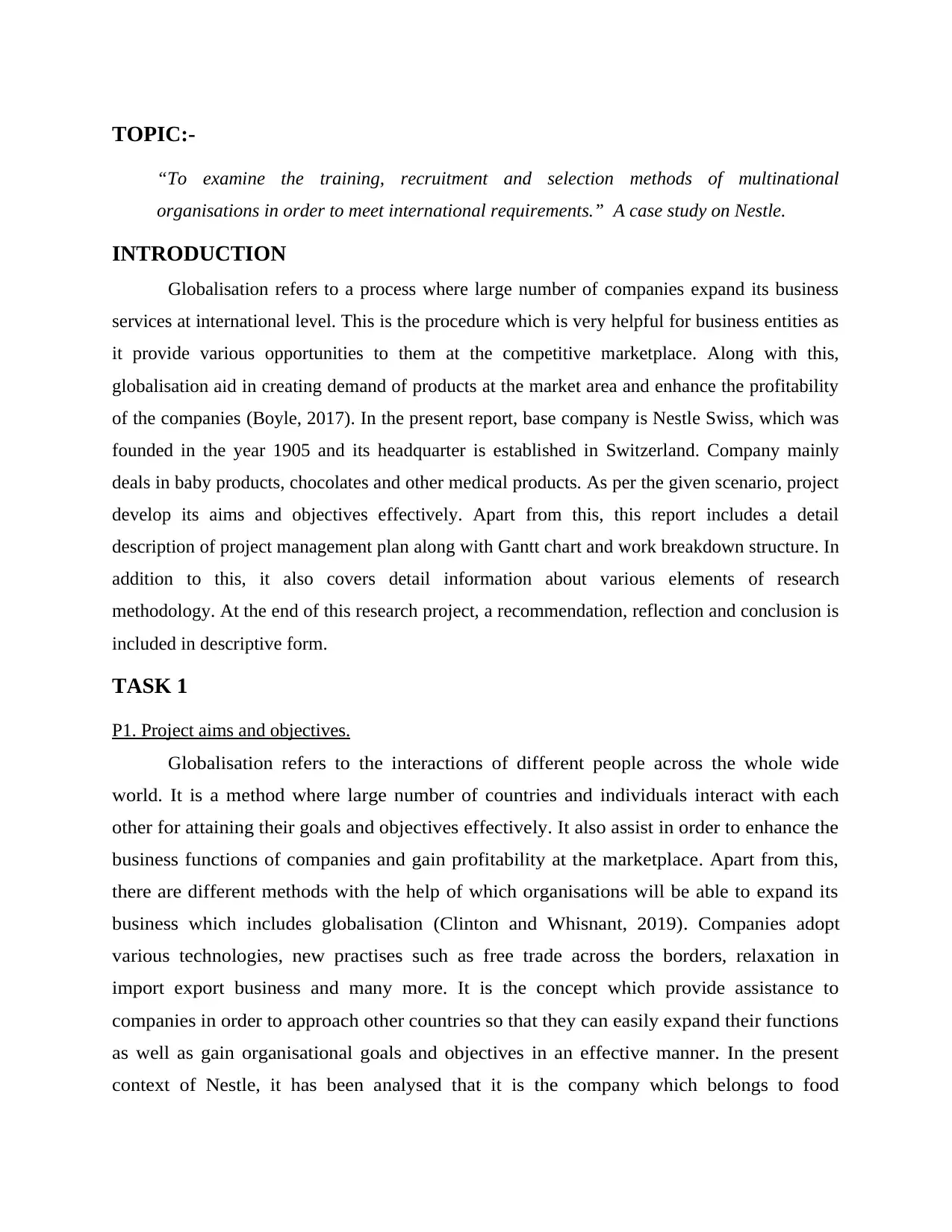
TOPIC:-
“To examine the training, recruitment and selection methods of multinational
organisations in order to meet international requirements.” A case study on Nestle.
INTRODUCTION
Globalisation refers to a process where large number of companies expand its business
services at international level. This is the procedure which is very helpful for business entities as
it provide various opportunities to them at the competitive marketplace. Along with this,
globalisation aid in creating demand of products at the market area and enhance the profitability
of the companies (Boyle, 2017). In the present report, base company is Nestle Swiss, which was
founded in the year 1905 and its headquarter is established in Switzerland. Company mainly
deals in baby products, chocolates and other medical products. As per the given scenario, project
develop its aims and objectives effectively. Apart from this, this report includes a detail
description of project management plan along with Gantt chart and work breakdown structure. In
addition to this, it also covers detail information about various elements of research
methodology. At the end of this research project, a recommendation, reflection and conclusion is
included in descriptive form.
TASK 1
P1. Project aims and objectives.
G lobalisation refers to the interactions of different people across the whole wide
world. It is a method where large number of countries and individuals interact with each
other for attaining their goals and objectives effectively. It also assist in order to enhance the
business functions of companies and gain profitability at the marketplace. Apart from this,
there are different methods with the help of which organisations will be able to expand its
business which includes globalisation (Clinton and Whisnant, 2019). Companies adopt
various technologies, new practises such as free trade across the borders, relaxation in
import export business and many more. It is the concept which provide assistance to
companies in order to approach other countries so that they can easily expand their functions
as well as gain organisational goals and objectives in an effective manner. In the present
context of Nestle, it has been analysed that it is the company which belongs to food
“To examine the training, recruitment and selection methods of multinational
organisations in order to meet international requirements.” A case study on Nestle.
INTRODUCTION
Globalisation refers to a process where large number of companies expand its business
services at international level. This is the procedure which is very helpful for business entities as
it provide various opportunities to them at the competitive marketplace. Along with this,
globalisation aid in creating demand of products at the market area and enhance the profitability
of the companies (Boyle, 2017). In the present report, base company is Nestle Swiss, which was
founded in the year 1905 and its headquarter is established in Switzerland. Company mainly
deals in baby products, chocolates and other medical products. As per the given scenario, project
develop its aims and objectives effectively. Apart from this, this report includes a detail
description of project management plan along with Gantt chart and work breakdown structure. In
addition to this, it also covers detail information about various elements of research
methodology. At the end of this research project, a recommendation, reflection and conclusion is
included in descriptive form.
TASK 1
P1. Project aims and objectives.
G lobalisation refers to the interactions of different people across the whole wide
world. It is a method where large number of countries and individuals interact with each
other for attaining their goals and objectives effectively. It also assist in order to enhance the
business functions of companies and gain profitability at the marketplace. Apart from this,
there are different methods with the help of which organisations will be able to expand its
business which includes globalisation (Clinton and Whisnant, 2019). Companies adopt
various technologies, new practises such as free trade across the borders, relaxation in
import export business and many more. It is the concept which provide assistance to
companies in order to approach other countries so that they can easily expand their functions
as well as gain organisational goals and objectives in an effective manner. In the present
context of Nestle, it has been analysed that it is the company which belongs to food
⊘ This is a preview!⊘
Do you want full access?
Subscribe today to unlock all pages.

Trusted by 1+ million students worldwide
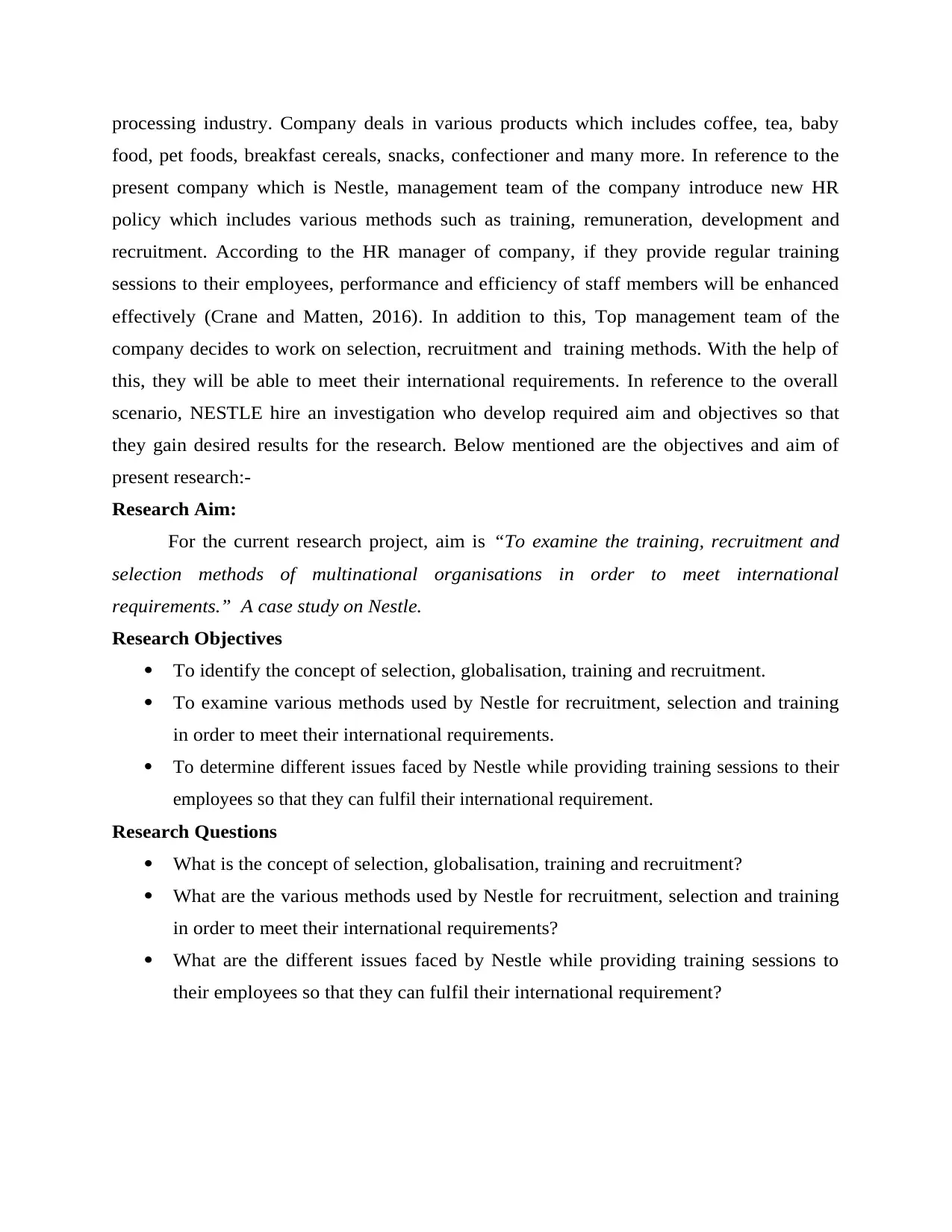
processing industry. Company deals in various products which includes coffee, tea, baby
food, pet foods, breakfast cereals, snacks, confectioner and many more. In reference to the
present company which is Nestle, management team of the company introduce new HR
policy which includes various methods such as training, remuneration, development and
recruitment. According to the HR manager of company, if they provide regular training
sessions to their employees, performance and efficiency of staff members will be enhanced
effectively (Crane and Matten, 2016). In addition to this, Top management team of the
company decides to work on selection, recruitment and training methods. With the help of
this, they will be able to meet their international requirements. In reference to the overall
scenario, NESTLE hire an investigation who develop required aim and objectives so that
they gain desired results for the research. Below mentioned are the objectives and aim of
present research:-
Research Aim:
For the current research project, aim is “To examine the training, recruitment and
selection methods of multinational organisations in order to meet international
requirements.” A case study on Nestle.
Research Objectives
To identify the concept of selection, globalisation, training and recruitment.
To examine various methods used by Nestle for recruitment, selection and training
in order to meet their international requirements.
To determine different issues faced by Nestle while providing training sessions to their
employees so that they can fulfil their international requirement.
Research Questions
What is the concept of selection, globalisation, training and recruitment?
What are the various methods used by Nestle for recruitment, selection and training
in order to meet their international requirements?
What are the different issues faced by Nestle while providing training sessions to
their employees so that they can fulfil their international requirement?
food, pet foods, breakfast cereals, snacks, confectioner and many more. In reference to the
present company which is Nestle, management team of the company introduce new HR
policy which includes various methods such as training, remuneration, development and
recruitment. According to the HR manager of company, if they provide regular training
sessions to their employees, performance and efficiency of staff members will be enhanced
effectively (Crane and Matten, 2016). In addition to this, Top management team of the
company decides to work on selection, recruitment and training methods. With the help of
this, they will be able to meet their international requirements. In reference to the overall
scenario, NESTLE hire an investigation who develop required aim and objectives so that
they gain desired results for the research. Below mentioned are the objectives and aim of
present research:-
Research Aim:
For the current research project, aim is “To examine the training, recruitment and
selection methods of multinational organisations in order to meet international
requirements.” A case study on Nestle.
Research Objectives
To identify the concept of selection, globalisation, training and recruitment.
To examine various methods used by Nestle for recruitment, selection and training
in order to meet their international requirements.
To determine different issues faced by Nestle while providing training sessions to their
employees so that they can fulfil their international requirement.
Research Questions
What is the concept of selection, globalisation, training and recruitment?
What are the various methods used by Nestle for recruitment, selection and training
in order to meet their international requirements?
What are the different issues faced by Nestle while providing training sessions to
their employees so that they can fulfil their international requirement?
Paraphrase This Document
Need a fresh take? Get an instant paraphrase of this document with our AI Paraphraser
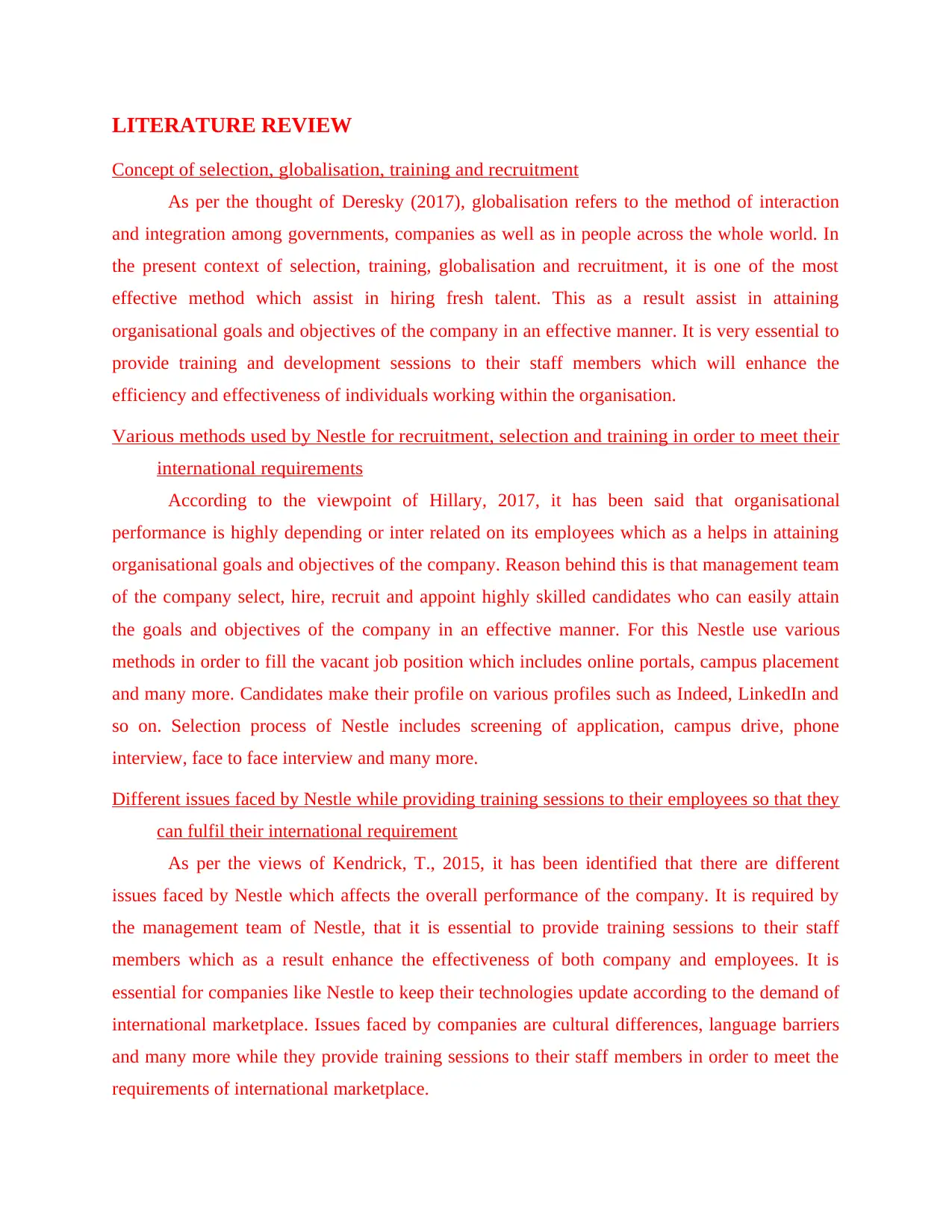
LITERATURE REVIEW
Concept of selection, globalisation, training and recruitment
As per the thought of Deresky (2017), globalisation refers to the method of interaction
and integration among governments, companies as well as in people across the whole world. In
the present context of selection, training, globalisation and recruitment, it is one of the most
effective method which assist in hiring fresh talent. This as a result assist in attaining
organisational goals and objectives of the company in an effective manner. It is very essential to
provide training and development sessions to their staff members which will enhance the
efficiency and effectiveness of individuals working within the organisation.
Various methods used by Nestle for recruitment, selection and training in order to meet their
international requirements
According to the viewpoint of Hillary, 2017, it has been said that organisational
performance is highly depending or inter related on its employees which as a helps in attaining
organisational goals and objectives of the company. Reason behind this is that management team
of the company select, hire, recruit and appoint highly skilled candidates who can easily attain
the goals and objectives of the company in an effective manner. For this Nestle use various
methods in order to fill the vacant job position which includes online portals, campus placement
and many more. Candidates make their profile on various profiles such as Indeed, LinkedIn and
so on. Selection process of Nestle includes screening of application, campus drive, phone
interview, face to face interview and many more.
Different issues faced by Nestle while providing training sessions to their employees so that they
can fulfil their international requirement
As per the views of Kendrick, T., 2015, it has been identified that there are different
issues faced by Nestle which affects the overall performance of the company. It is required by
the management team of Nestle, that it is essential to provide training sessions to their staff
members which as a result enhance the effectiveness of both company and employees. It is
essential for companies like Nestle to keep their technologies update according to the demand of
international marketplace. Issues faced by companies are cultural differences, language barriers
and many more while they provide training sessions to their staff members in order to meet the
requirements of international marketplace.
Concept of selection, globalisation, training and recruitment
As per the thought of Deresky (2017), globalisation refers to the method of interaction
and integration among governments, companies as well as in people across the whole world. In
the present context of selection, training, globalisation and recruitment, it is one of the most
effective method which assist in hiring fresh talent. This as a result assist in attaining
organisational goals and objectives of the company in an effective manner. It is very essential to
provide training and development sessions to their staff members which will enhance the
efficiency and effectiveness of individuals working within the organisation.
Various methods used by Nestle for recruitment, selection and training in order to meet their
international requirements
According to the viewpoint of Hillary, 2017, it has been said that organisational
performance is highly depending or inter related on its employees which as a helps in attaining
organisational goals and objectives of the company. Reason behind this is that management team
of the company select, hire, recruit and appoint highly skilled candidates who can easily attain
the goals and objectives of the company in an effective manner. For this Nestle use various
methods in order to fill the vacant job position which includes online portals, campus placement
and many more. Candidates make their profile on various profiles such as Indeed, LinkedIn and
so on. Selection process of Nestle includes screening of application, campus drive, phone
interview, face to face interview and many more.
Different issues faced by Nestle while providing training sessions to their employees so that they
can fulfil their international requirement
As per the views of Kendrick, T., 2015, it has been identified that there are different
issues faced by Nestle which affects the overall performance of the company. It is required by
the management team of Nestle, that it is essential to provide training sessions to their staff
members which as a result enhance the effectiveness of both company and employees. It is
essential for companies like Nestle to keep their technologies update according to the demand of
international marketplace. Issues faced by companies are cultural differences, language barriers
and many more while they provide training sessions to their staff members in order to meet the
requirements of international marketplace.
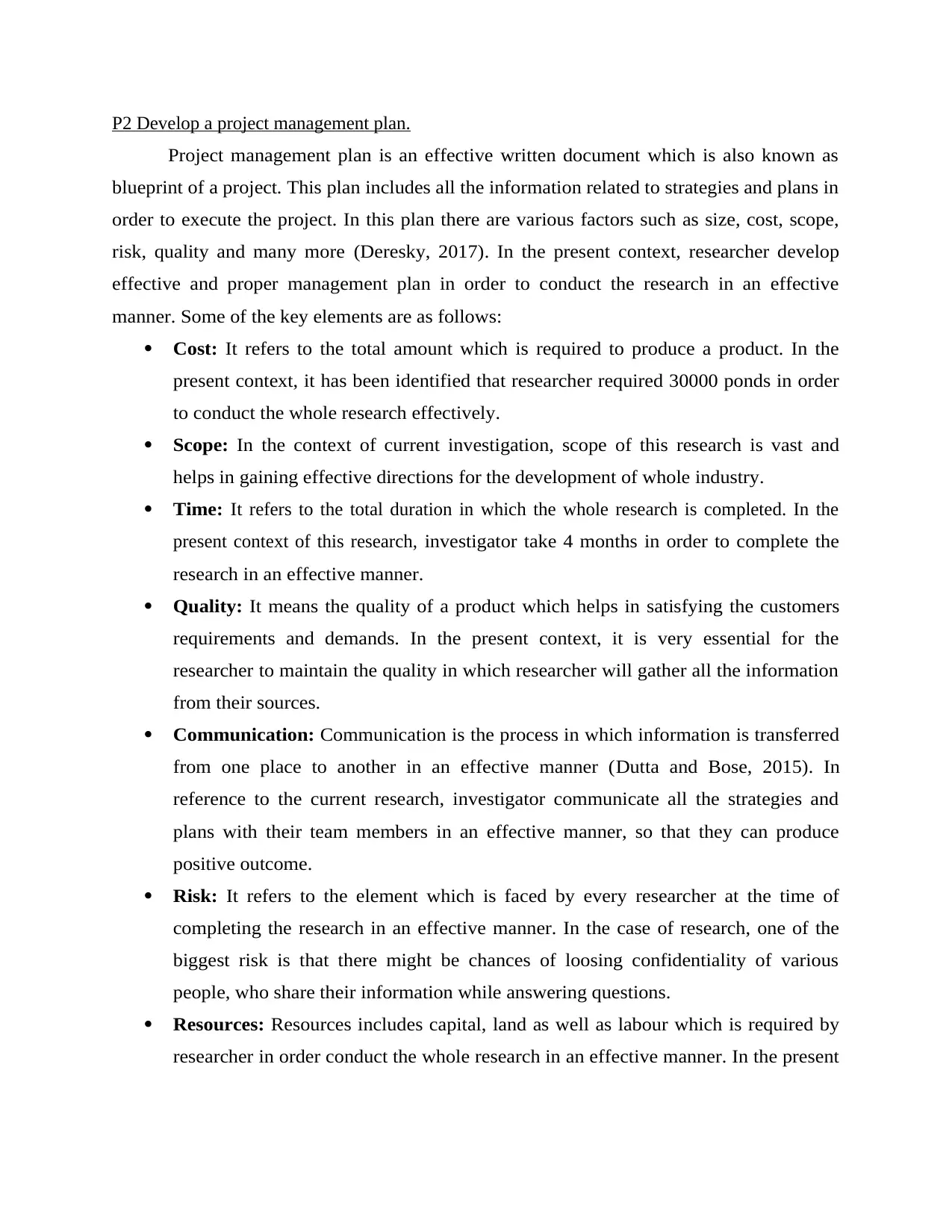
P2 Develop a project management plan.
Project management plan is an effective written document which is also known as
blueprint of a project. This plan includes all the information related to strategies and plans in
order to execute the project. In this plan there are various factors such as size, cost, scope,
risk, quality and many more (Deresky, 2017). In the present context, researcher develop
effective and proper management plan in order to conduct the research in an effective
manner. Some of the key elements are as follows:
Cost: It refers to the total amount which is required to produce a product. In the
present context, it has been identified that researcher required 30000 ponds in order
to conduct the whole research effectively.
Scope: In the context of current investigation, scope of this research is vast and
helps in gaining effective directions for the development of whole industry.
Time: It refers to the total duration in which the whole research is completed. In the
present context of this research, investigator take 4 months in order to complete the
research in an effective manner.
Quality: It means the quality of a product which helps in satisfying the customers
requirements and demands. In the present context, it is very essential for the
researcher to maintain the quality in which researcher will gather all the information
from their sources.
Communication: Communication is the process in which information is transferred
from one place to another in an effective manner (Dutta and Bose, 2015). In
reference to the current research, investigator communicate all the strategies and
plans with their team members in an effective manner, so that they can produce
positive outcome.
Risk: It refers to the element which is faced by every researcher at the time of
completing the research in an effective manner. In the case of research, one of the
biggest risk is that there might be chances of loosing confidentiality of various
people, who share their information while answering questions.
Resources: Resources includes capital, land as well as labour which is required by
researcher in order conduct the whole research in an effective manner. In the present
Project management plan is an effective written document which is also known as
blueprint of a project. This plan includes all the information related to strategies and plans in
order to execute the project. In this plan there are various factors such as size, cost, scope,
risk, quality and many more (Deresky, 2017). In the present context, researcher develop
effective and proper management plan in order to conduct the research in an effective
manner. Some of the key elements are as follows:
Cost: It refers to the total amount which is required to produce a product. In the
present context, it has been identified that researcher required 30000 ponds in order
to conduct the whole research effectively.
Scope: In the context of current investigation, scope of this research is vast and
helps in gaining effective directions for the development of whole industry.
Time: It refers to the total duration in which the whole research is completed. In the
present context of this research, investigator take 4 months in order to complete the
research in an effective manner.
Quality: It means the quality of a product which helps in satisfying the customers
requirements and demands. In the present context, it is very essential for the
researcher to maintain the quality in which researcher will gather all the information
from their sources.
Communication: Communication is the process in which information is transferred
from one place to another in an effective manner (Dutta and Bose, 2015). In
reference to the current research, investigator communicate all the strategies and
plans with their team members in an effective manner, so that they can produce
positive outcome.
Risk: It refers to the element which is faced by every researcher at the time of
completing the research in an effective manner. In the case of research, one of the
biggest risk is that there might be chances of loosing confidentiality of various
people, who share their information while answering questions.
Resources: Resources includes capital, land as well as labour which is required by
researcher in order conduct the whole research in an effective manner. In the present
⊘ This is a preview!⊘
Do you want full access?
Subscribe today to unlock all pages.

Trusted by 1+ million students worldwide

context, investigator need enough amount of funds, effective human resource,
upgraded technologies and many more.
P3 Gantt chart and work break down structure.
GANTT CHART
It is developed in the year 1910 by Henry Gantt. This chart helps in determining the
time required in order to perform activities in an effective manner. It is one of the most
important tool used by researcher which shows the time duration in the form of graphical
representation (Glukhov, Ilin and Levina, 2015). With the help of this, investigator can
perform their task as per the pre defined time period. Therefore, the projects will be
completed on time and does not get delayed.
upgraded technologies and many more.
P3 Gantt chart and work break down structure.
GANTT CHART
It is developed in the year 1910 by Henry Gantt. This chart helps in determining the
time required in order to perform activities in an effective manner. It is one of the most
important tool used by researcher which shows the time duration in the form of graphical
representation (Glukhov, Ilin and Levina, 2015). With the help of this, investigator can
perform their task as per the pre defined time period. Therefore, the projects will be
completed on time and does not get delayed.
Paraphrase This Document
Need a fresh take? Get an instant paraphrase of this document with our AI Paraphraser
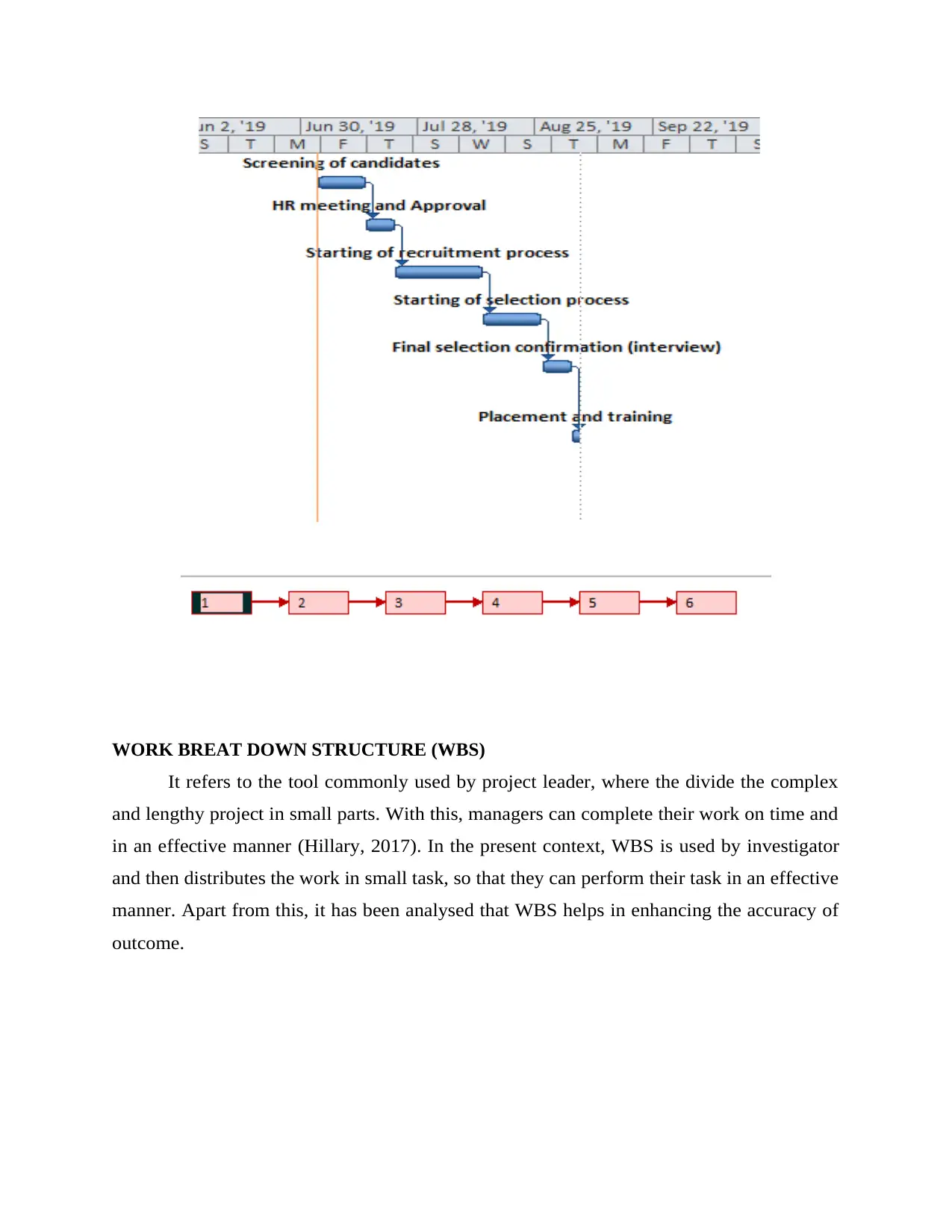
WORK BREAT DOWN STRUCTURE (WBS)
It refers to the tool commonly used by project leader, where the divide the complex
and lengthy project in small parts. With this, managers can complete their work on time and
in an effective manner (Hillary, 2017). In the present context, WBS is used by investigator
and then distributes the work in small task, so that they can perform their task in an effective
manner. Apart from this, it has been analysed that WBS helps in enhancing the accuracy of
outcome.
It refers to the tool commonly used by project leader, where the divide the complex
and lengthy project in small parts. With this, managers can complete their work on time and
in an effective manner (Hillary, 2017). In the present context, WBS is used by investigator
and then distributes the work in small task, so that they can perform their task in an effective
manner. Apart from this, it has been analysed that WBS helps in enhancing the accuracy of
outcome.

⊘ This is a preview!⊘
Do you want full access?
Subscribe today to unlock all pages.

Trusted by 1+ million students worldwide
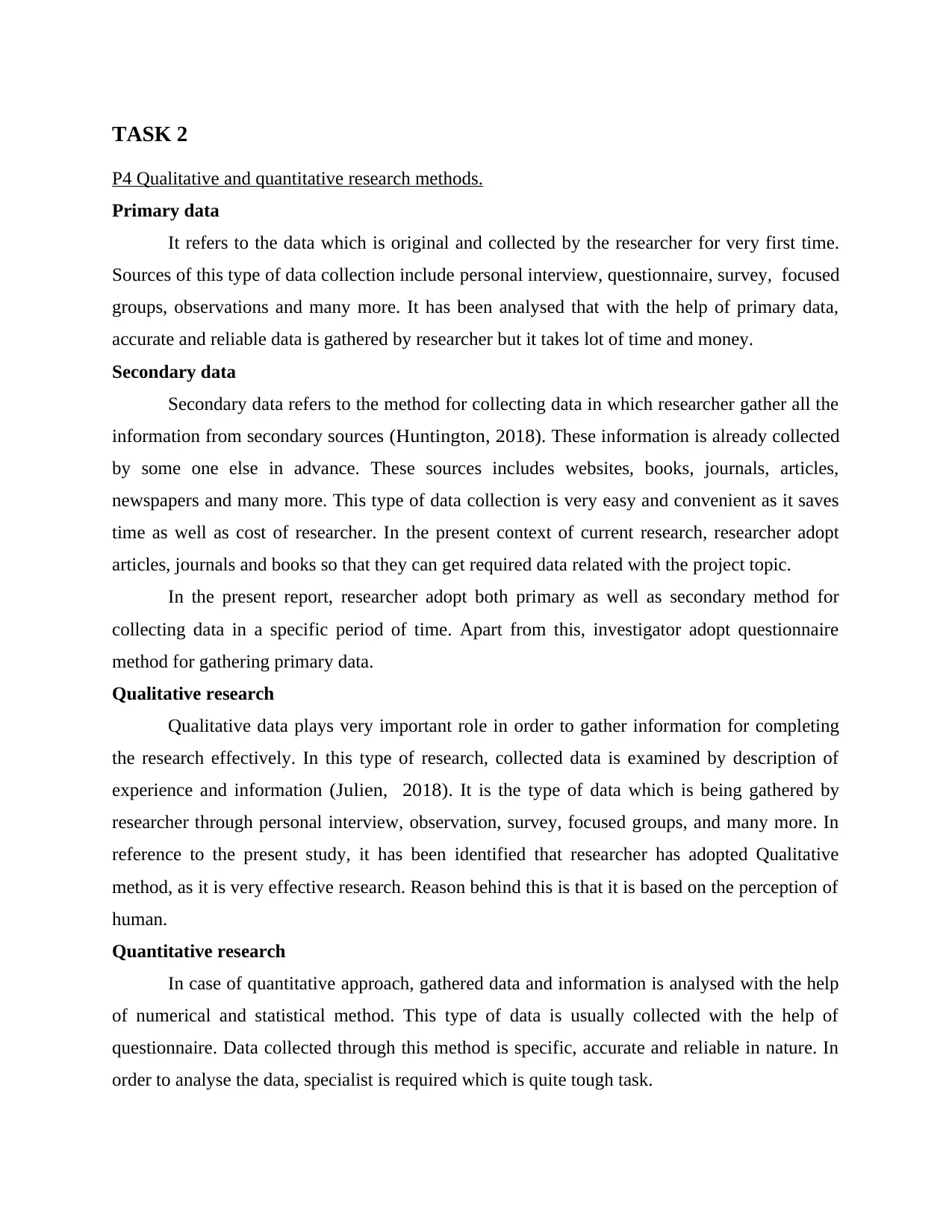
TASK 2
P4 Qualitative and quantitative research methods.
Primary data
It refers to the data which is original and collected by the researcher for very first time.
Sources of this type of data collection include personal interview, questionnaire, survey, focused
groups, observations and many more. It has been analysed that with the help of primary data,
accurate and reliable data is gathered by researcher but it takes lot of time and money.
Secondary data
Secondary data refers to the method for collecting data in which researcher gather all the
information from secondary sources (Huntington, 2018). These information is already collected
by some one else in advance. These sources includes websites, books, journals, articles,
newspapers and many more. This type of data collection is very easy and convenient as it saves
time as well as cost of researcher. In the present context of current research, researcher adopt
articles, journals and books so that they can get required data related with the project topic.
In the present report, researcher adopt both primary as well as secondary method for
collecting data in a specific period of time. Apart from this, investigator adopt questionnaire
method for gathering primary data.
Qualitative research
Qualitative data plays very important role in order to gather information for completing
the research effectively. In this type of research, collected data is examined by description of
experience and information (Julien, 2018). It is the type of data which is being gathered by
researcher through personal interview, observation, survey, focused groups, and many more. In
reference to the present study, it has been identified that researcher has adopted Qualitative
method, as it is very effective research. Reason behind this is that it is based on the perception of
human.
Quantitative research
In case of quantitative approach, gathered data and information is analysed with the help
of numerical and statistical method. This type of data is usually collected with the help of
questionnaire. Data collected through this method is specific, accurate and reliable in nature. In
order to analyse the data, specialist is required which is quite tough task.
P4 Qualitative and quantitative research methods.
Primary data
It refers to the data which is original and collected by the researcher for very first time.
Sources of this type of data collection include personal interview, questionnaire, survey, focused
groups, observations and many more. It has been analysed that with the help of primary data,
accurate and reliable data is gathered by researcher but it takes lot of time and money.
Secondary data
Secondary data refers to the method for collecting data in which researcher gather all the
information from secondary sources (Huntington, 2018). These information is already collected
by some one else in advance. These sources includes websites, books, journals, articles,
newspapers and many more. This type of data collection is very easy and convenient as it saves
time as well as cost of researcher. In the present context of current research, researcher adopt
articles, journals and books so that they can get required data related with the project topic.
In the present report, researcher adopt both primary as well as secondary method for
collecting data in a specific period of time. Apart from this, investigator adopt questionnaire
method for gathering primary data.
Qualitative research
Qualitative data plays very important role in order to gather information for completing
the research effectively. In this type of research, collected data is examined by description of
experience and information (Julien, 2018). It is the type of data which is being gathered by
researcher through personal interview, observation, survey, focused groups, and many more. In
reference to the present study, it has been identified that researcher has adopted Qualitative
method, as it is very effective research. Reason behind this is that it is based on the perception of
human.
Quantitative research
In case of quantitative approach, gathered data and information is analysed with the help
of numerical and statistical method. This type of data is usually collected with the help of
questionnaire. Data collected through this method is specific, accurate and reliable in nature. In
order to analyse the data, specialist is required which is quite tough task.
Paraphrase This Document
Need a fresh take? Get an instant paraphrase of this document with our AI Paraphraser

In the present context, qualitative approach is used by researcher so that they can
accomplish their task in an effective manner.
Sampling
It refers to selecting some candidates from huge number of candidates so that researcher
will be able to gather relevant information in an effective manner (Kendrick, 2015). In the
present research, random sampling technique is used by investigator. In the present report, 30
respondents have been chosen for gathering information.
Questionnaire
Q 1) Do you know the concept of recruitment, globalisation, selection and training?
a) Yes
b) No
Q 2) Do you think, globalisation influence the process of recruitment in NESTLE while
international expansion of business?
a) Yes
b) No
Q 3) According to your view, does globalisation aid NESTLE in approaching skilled
candidates?
a) Agree
b) Disagree
Q 4) As per your thought, is there any requirement for NESTLE to provide training sessions to
their staff members while expanding business at international market?
a) Agree
b) Disagree
Q 5) What are the major advantages gain by NESTLE while using recruitment strategy?
a) Attracts new customers
b) Increases market share
c) Increase in profitability of company
accomplish their task in an effective manner.
Sampling
It refers to selecting some candidates from huge number of candidates so that researcher
will be able to gather relevant information in an effective manner (Kendrick, 2015). In the
present research, random sampling technique is used by investigator. In the present report, 30
respondents have been chosen for gathering information.
Questionnaire
Q 1) Do you know the concept of recruitment, globalisation, selection and training?
a) Yes
b) No
Q 2) Do you think, globalisation influence the process of recruitment in NESTLE while
international expansion of business?
a) Yes
b) No
Q 3) According to your view, does globalisation aid NESTLE in approaching skilled
candidates?
a) Agree
b) Disagree
Q 4) As per your thought, is there any requirement for NESTLE to provide training sessions to
their staff members while expanding business at international market?
a) Agree
b) Disagree
Q 5) What are the major advantages gain by NESTLE while using recruitment strategy?
a) Attracts new customers
b) Increases market share
c) Increase in profitability of company

Q 6) Which one of the following is considered as the biggest challenge of globalisation for
NESTLE while expanding its business functions internationally?
a) Change in technology
b) Language barrier
c) Recruiting loyal employees
Q 7) Do you think there is any kind of changes arise within the NESTLE after adopting
recruitment policy?
a) Yes
b) No
Q 8) Give recommendations to managers of NESTLE through which it can provide effective
training to employees.
Q 9) What are the problems faced by NESTLE while recruiting candidates.
TASK 3
P5 Data analysis.
Theme 1: Concept of globalisation
Q 1) Are you aware with the concept of globalisation? Frequency
a) Yes 25
b) No 5
NESTLE while expanding its business functions internationally?
a) Change in technology
b) Language barrier
c) Recruiting loyal employees
Q 7) Do you think there is any kind of changes arise within the NESTLE after adopting
recruitment policy?
a) Yes
b) No
Q 8) Give recommendations to managers of NESTLE through which it can provide effective
training to employees.
Q 9) What are the problems faced by NESTLE while recruiting candidates.
TASK 3
P5 Data analysis.
Theme 1: Concept of globalisation
Q 1) Are you aware with the concept of globalisation? Frequency
a) Yes 25
b) No 5
⊘ This is a preview!⊘
Do you want full access?
Subscribe today to unlock all pages.

Trusted by 1+ million students worldwide
1 out of 28
Related Documents
Your All-in-One AI-Powered Toolkit for Academic Success.
+13062052269
info@desklib.com
Available 24*7 on WhatsApp / Email
![[object Object]](/_next/static/media/star-bottom.7253800d.svg)
Unlock your academic potential
Copyright © 2020–2025 A2Z Services. All Rights Reserved. Developed and managed by ZUCOL.





